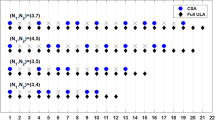Abstract
An array extension method in a noisy environment was proposed to improve angular resolution and array gain. The proposed method combines the FOC (fourth-order cumulants) technique with the ETAM (extended towed array measurements) method to extend array aperture and suppress Gaussian noise. First, successive measurements of a virtual uniform linear array were constructed by applying fourth-order cumulants to measurements of uniform linear array; Gaussian noise in these measurements was also eliminated. Then, the array was extended by compensating phase differences using the ETAM method. Finally, the synthetic aperture was extended further by the fourth-order cumulants technique. The proposed FOC-ETAM-FOC method not only improves angular resolution and array gain, but also effectively suppresses Gaussian noise. Furthermore, it inherits the advantages of the ETAM method. Simulation results showed that the FOC-ETAM-FOC method achieved better angular resolution and array gain than the ETAM method. Furthermore this method outperforms the ETAM method in Gaussian noise environment.
Similar content being viewed by others
References
Blagouchine IV, Moreau E (2009). Unbiased adaptive estimations of the fourth-order cumulant for real random zero-mean signal. IEEE Trans. on Signal Processing, 57(9), 3330–3346.
Diao Ming, Wu Xiaoqiang, Li Xiaogang (2008). Study on DOA estimation based on fourth-order cumulant. Systems Engineering and Electronics, 30(2), 226–228.
Dogan MC, Mendel JM (1995). Applications of cumulants to array signal processing-part I: aperture extension and array calibration. IEEE Trans. on Signal Processing, 43(5), 1200–1216.
Hayes MP, Gough PT (2009). Synthetic aperture sonar: a review of current status. IEEE J. Ocean Eng., 34(3), 207–224.
Hou Yunshan, Huang jiangguo, Jiang Min, Jin Yong (2010). Application of linear prediction technique to passive synthetic aperture processing. EURASIP Journal on Advance in Signal Processing.
Jiang Biao, Chen Fuhu, Ling Guomin (2007). Research on fourth-order MUSIC algorithm for virtual arrays. Journal Of Harbin Enginering University, 28(10), 1122–1126.
Li Bo, Sun Chao (2010). A new method for array extension based on minimum redundancy linear array. IEEE International Conference on Signal Processing, Beijing, 332–335.
Pascal Chevalier, Laurent Albera, Anne Ferréol, Pierre Comon (2005). On the virtual array concept for higher order array processing. IEEE Trans. on Signal Processing, 53(4), 1254–1271.
Stergiopoulos S, Sullivan EJ (1989). Extended towed array processing by an overlap correlator. J. Acoust. Soc. Am., 86(1), 158–171.
Stergiopoulos S, Urban H (1992a). An experimental study in forming a long synthetic aperure at sea. IEEE J. Ocean Eng., 17(1), 62–72.
Stergiopoulos S, Urban H (1992b). A new passive acoustic synthetic aperture technique for towed arrays. IEEE J. Ocean Eng., 17(1), 16–25.
Stergiopoulos S (2001). Advanced signal processing handbook. CRC Press LCC, Abingdong, 45–63.
Seungil Kim, Dae Hee Youn, Chungyong Lee (2002). Temporal domain processing for a synthetic aperture array. IEEE J. Ocean Eng., 27(2), 322–327.
Tang Jianhong, Si Xicai, Peng Qianle (2009). Estimation of signal parameters via rotational invariance techniques algorithm with speedy fourth-order cumulants. Journal of Xi’an Jiaotong University, 43(6), 88–92.
Wang Yongliang, Chen Hui, Peng Yingning (2004). The theory and aalgorithm of spatial spectrum estimation. Tsinghua University Press, Beijing, 359–364.
Wu Sijun, Zhang Jinzhong, Zhang Shu (2005). Study of array extend based on fouth-order cumulant. Journal Of Harbin Enginering University, 26(3), 394–397.
Yen NC, Carey W (1989). Application of synthetic aperture processing to towed-array data. J. Acoust. Soc. Am., 86(2), 754–765.
Author information
Authors and Affiliations
Corresponding author
Additional information
Foundation item: Supported by the National Science Foundation of China (No.60872146)
Bo Li was born in 1983. She is a Ph.D candidate at the College of Marine, Northwestern Polytechnical University. Her current research interests include underwater acoustic signal processing and array signal processing.
Chao Sun was born in 1965. She is a professor, doctoral advisor and department head of Institute of Acoustics Engineering in Northwestern Polytechnical University. She works in the field of sonar technology and underwater acoustic signal processing, etc.
Rights and permissions
About this article
Cite this article
Li, B., Sun, C. An array extension method in a noisy environment. J. Marine. Sci. Appl. 10, 226–232 (2011). https://doi.org/10.1007/s11804-011-1063-4
Received:
Published:
Issue Date:
DOI: https://doi.org/10.1007/s11804-011-1063-4




